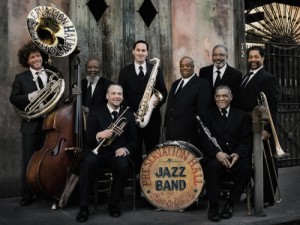The Preservation Hall Jazz Band has spent the last few years establishing itself more than just the flag bearer for one stream of New Orleans music. Starting with the inclusion of Clint Maedgen and Carl LeBlanc (for a period) in the band’s lineup, the band has worked to be recognized as a part of American culture, underscoring the point that musicians make time and again—that music is music and genre labels are put on it by others. Sunday on the Gentilly Stage, the Hall Band and friends dramatized that point in a show that was largely but not solely a celebration of New Orleans music and the band’s place in it.
In some cases, the results were thrilling, such as when Trombone Shorty joined in for “It Ain’t My Fault” and Jim James from My Morning Jacket sang “St. James Infirmary” with less reverb on his voice than usual. Segments with Ani DiFranco, Steve Earle, and Allen Toussaint with Bonnie Raitt connected the band to larger musical traditions, and the final “I’ll Fly Away” was more rousing than everybody-on-stage closers often are. The only odd moment came with the Rebirth Brass Band. It joined with the Preservation Hall Jazz Band for a version of “Do Whatcha Wanna” that largely obscured the Hall Band not through intention but because the communal nature of the brass band sound makes it the dominant voice. Then they did a version of “Let’s Get it On” that was simply mystifying as it was neither a Rebirth composition nor a song that had much to do with the Hall. The segment was still a lot of fun, but it didn’t further the narrative. It also had one sweet touch. While many bands act too cool to care about Grammys and awards, Rebirth had somebody onstage with them to show off its Grammy.
In other Jazz Fest notes:
– I was scheduled to interview Asleep at the Wheel’s Ray Benson and Jason Roberts after David Fricke’s interview of Ben Sandmel, Allen Toussaint and Walter “Wolfman” Washington on Ernie K-Doe. At one point, Toussaint played “Hello My Lover” and Benson and Roberts stopped tuning their guitar and violin respectively to pick up the song and join in. It wasn’t audible outside the stage’s green room, but they both obviously enjoyed it. “Now I can say I jammed with Allen Toussaint,” Benson said when the song was done.
– Foo Fighters were certainly the loudest band I can remember seeing at Jazz Fest, loud enough that I could not only hear them at the Congo Square Stage, but I could hear them well enough to know what they were playing. It was louder at the back than it was up front, and more than that, it was hard. The latter reminded me why I like-don’t-love Foo Fighters—because there’s no room in their songs. They’re full of sound with three guitars, keys, bass, drums, and Dave Grohl’s full-throated, raw vocals, which were as in-your-face as any guitar. The band’s to be applauded for working as hard on the first song as it does on the last, but it also means that there’s no way for the set to grow and become more intense without fireworks or blood sacrifice. The band could go quieter as it did for a surprisingly faithful cover of Tom Petty’s “Breakdown,” but it couldn’t get harder than hard. The set ended well with a run through the earlier hits which were, tellingly, more dynamic, less raging songs. A rampaging “Everlong” was exciting precisely because it wasn’t as heavy or relentless the first time around.
– Supagroup performed earlier in the day on the Acura Stage and it sounded like the natural setting for the band. Its songs were made to crunch out of towers of speakers over a pasture of people, and it looked like it was reaching people as the crowd grew and was visibly engaged over the course of the set (with the exception of one Foo Fighters fan who sat and made Dungeons and Dragons characters). The challenge is how to get from bar to the stadium.





